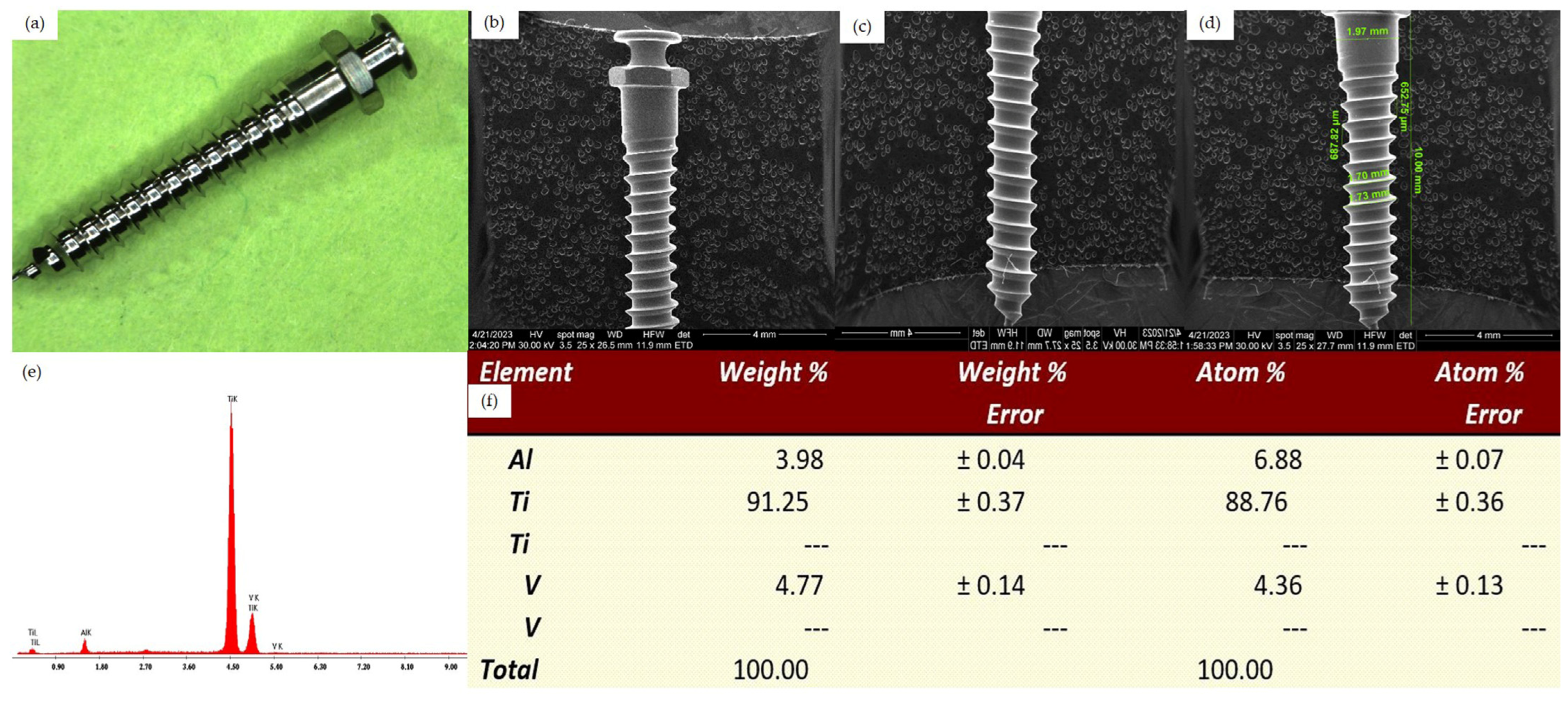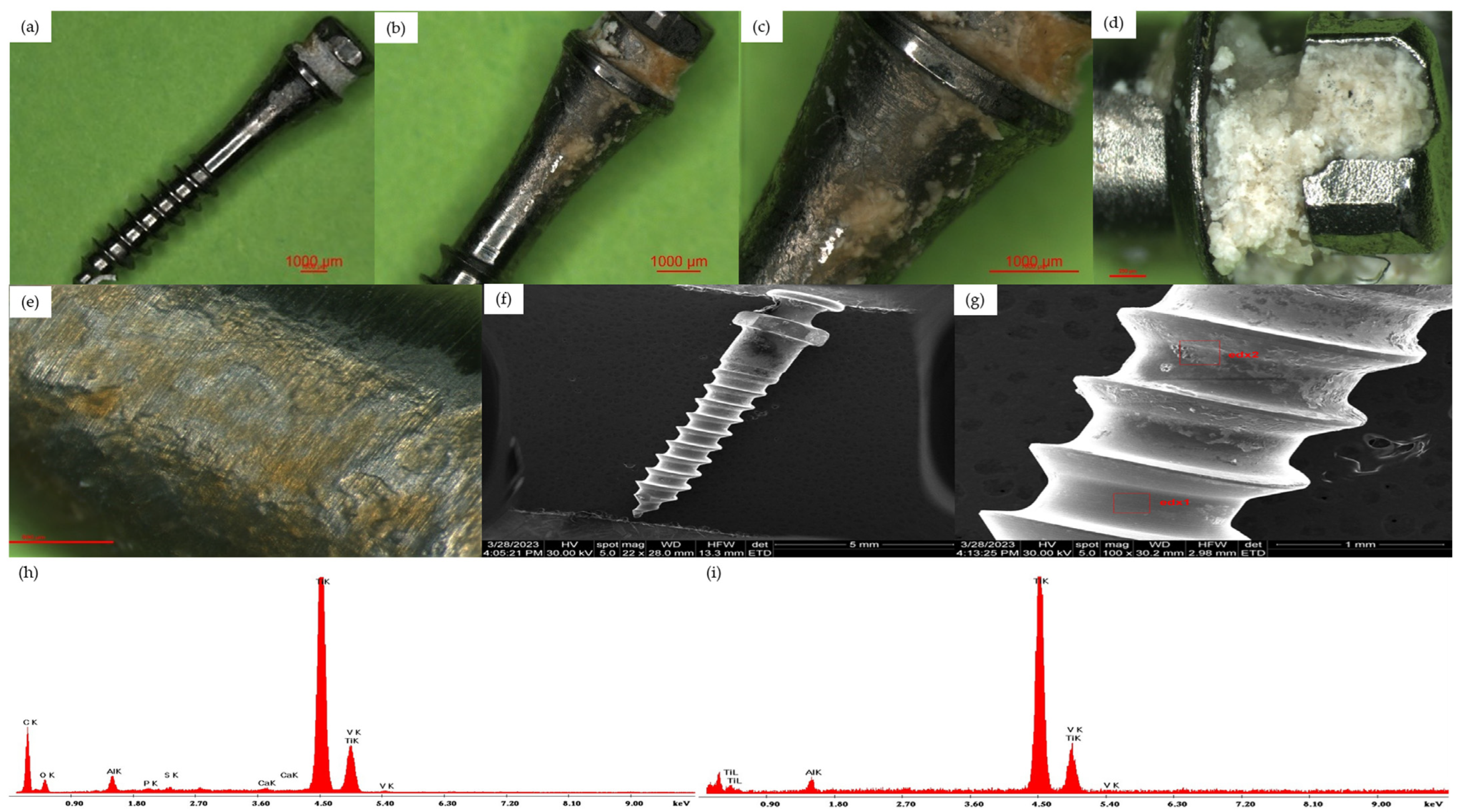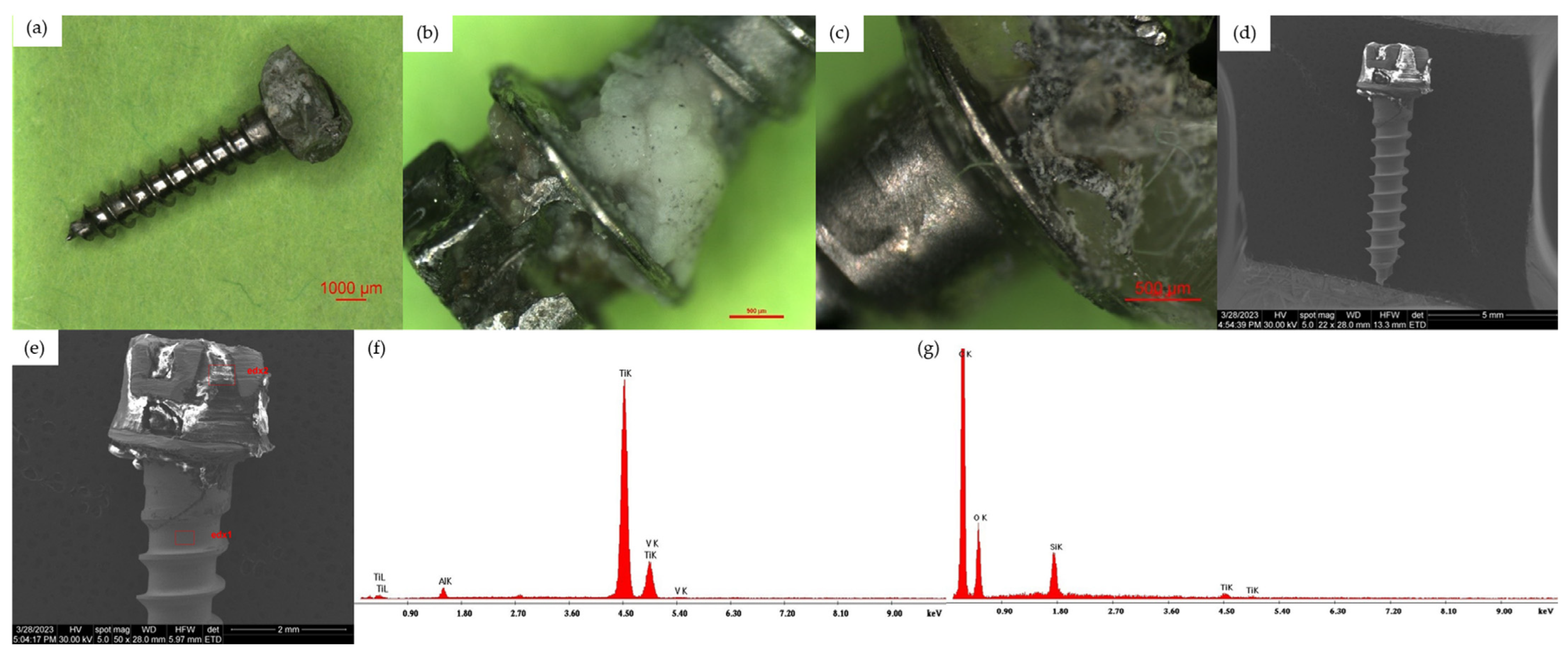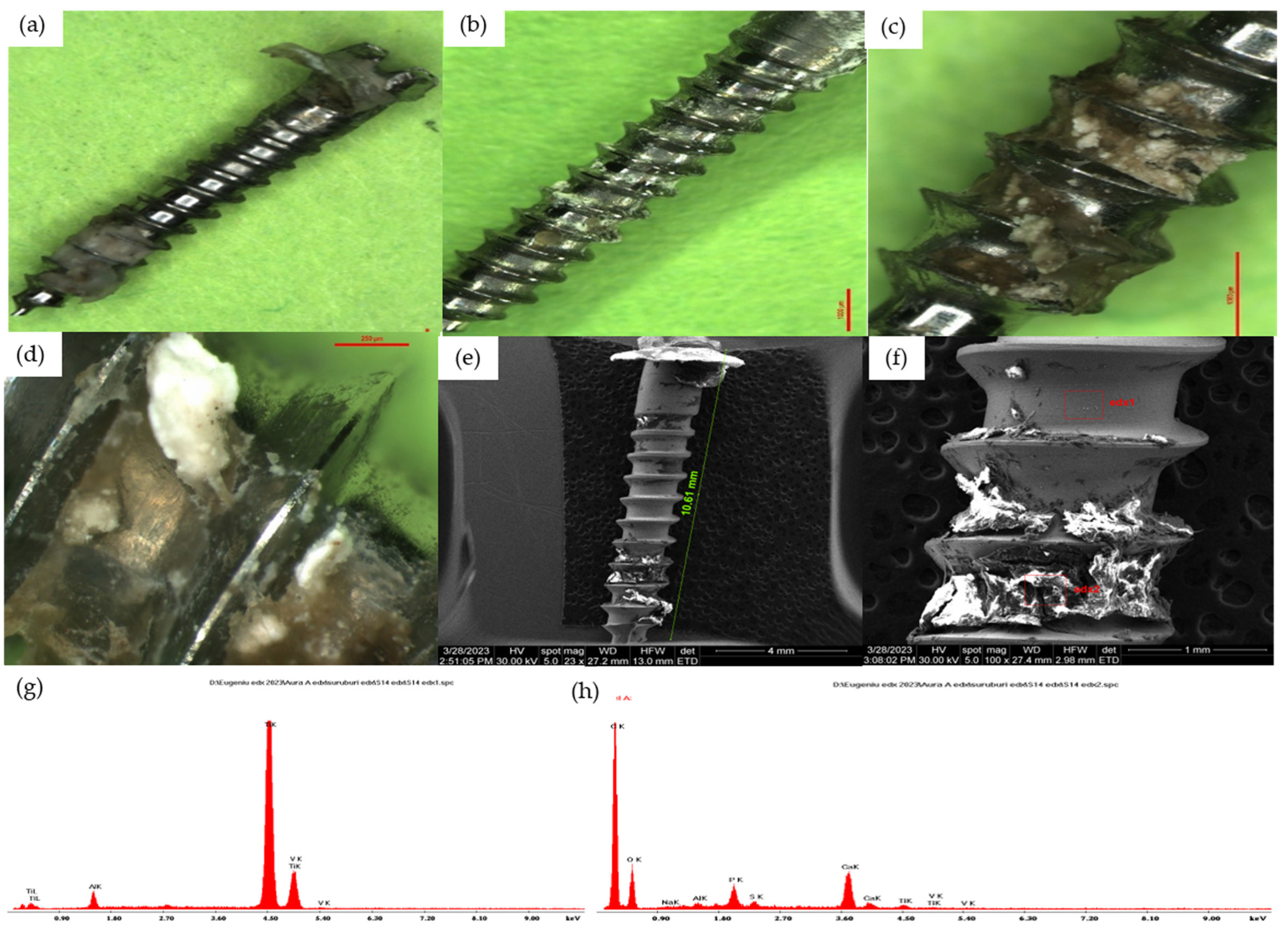Surface Analysis of Orthodontic Mini-Implants after Their Clinical Use
Abstract
:1. Introduction
2. Materials and Methods
- Insertion and removal
- 2.
- Storage
- 3.
- Optical microscopy analysis
- −
- Z1—the surface of the mini-implant head that remains free in the oral cavity and to which the metal ligatures or elastic orthodontic wires are attached, a surface that is later covered with acrylate most of the time for the patient’s comfort.
- −
- Z2—the cervical surface (the transmucosal profile that will be covered by soft gingival–mucosal connective tissue) and the cervical third of the body (the active part inserted intraosseously).
- −
- Z3—the surface of the middle third of the body.
- −
- Z4—the surface of the apical third of the body—the TAD tip.
- 4.
- Scanning electron microscopy (SEM) analysis
3. Results
4. Discussion
5. Conclusions
Author Contributions
Funding
Institutional Review Board Statement
Informed Consent Statement
Data Availability Statement
Conflicts of Interest
References
- Łyczek, J.; Kawala, B.; Antoszewska-Smith, J. Influence of antibiotic prophylaxis on the stability of orthodontic microimplants: A pilot randomized controlled trial. Am. J. Orthod. Dentofac. Orthop. 2018, 153, 621–631. [Google Scholar] [CrossRef]
- Giri, M.; Sabapathy, K.; Govindasamy, B.; Rajamurugan, H. Evaluation of insertion torque and surface integrity of zirconia-coated titanium mini screw implants. J. World Fed. Orthod. 2020, 9, 13–17. [Google Scholar] [CrossRef]
- Becker, K.; Pliska, A.; Busch, C.; Wilmes, B.; Wolf, M.; Drescher, D. Efficacy of orthodontic mini implants for en masse retraction in the maxilla: A systematic review and meta-analysis. Int. J. Implant Dent. 2018, 4, 35. [Google Scholar] [CrossRef]
- Moldoveanu, A.; Nicolescu, M.I.; Bucur, M.V.; Moldoveanu, G.G.; Funieru, C.; Neagoe, I.V.; Manda, G.; Ioana, T.R.; Ciocan, L.T. In vitro study of the orthodontic mini-implants influence on the growth of human osteoblasts. Rom. J. Morphol. Embryol. 2021, 62, 785–792. [Google Scholar] [CrossRef] [PubMed]
- Ramírez-Ossa, D.M.; Escobar-Correa, N.; Ramírez-Bustamante, M.A.; Agudelo-Suárez, A.A. An Umbrella Review of the Effectiveness of Temporary Anchorage Devices and the Factors That Contribute to Their Success or Failure. J. Evid. Based Dent. Pract. 2020, 20, 101402. [Google Scholar] [CrossRef]
- Nienkemper, M.; Willmann, J.H.; Drescher, D. Long-term stability behavior of para-median palatal mini-implants: A repeated cross-sectional study. Am. J. Orthod. Dentofac. Orthop. 2020, 157, 165–171. [Google Scholar] [CrossRef]
- Liu, Y.; Yang, Z.J.; Zhou, J.; Xiong, P.; Wang, Q.; Yang, Y.; Hu, Y.; Hu, J.T. Comparison of Anchorage Efficiency of Orthodontic Mini-implant and Conventional Anchorage Reinforcement in Patients Requiring Maximum Orthodontic Anchorage: A Systematic Review and Meta-analysis. J. Evid. Based Dent. Pract. 2020, 20, 101401. [Google Scholar] [CrossRef] [PubMed]
- Colonna, A.; Drudi, M.; Spedicato, G.A.; Mollica, F.; Mazzanti, V.; Paoletto, E.; Maino, G.; Siciliani, G.; Lombardo, L. Assessment of stiffness and load deflection of orthodontic miniscrews used for palatal anchorage: An in vitro biomechanical study. Int. Orthod. 2020, 18, 809–819. [Google Scholar] [CrossRef] [PubMed]
- Marchi, A.; Camporesi, M.; Festa, M.; Salvatierra, L.; Izadi, S.; Farronato, G. Drilling Capability of Orthodontic Miniscrews: In Vitro Study. Dent. J. 2020, 8, 138. [Google Scholar] [CrossRef]
- Abu Al-Melh, M.M.; Al-Anzi, A.N. Knowledge of undergraduate dental students toward orthodontic skeletal temporary anchorage devices at Kuwait University. BMC Med. Educ. 2020, 20, 340. [Google Scholar] [CrossRef]
- Tatli, U.; Alraawi, M.; Toroğlu, M.S. Effects of size and insertion angle of orthodontic mini-implants on skeletal anchorage. Am. J. Orthod. Dentofac. Orthop. 2019, 156, 220–228. [Google Scholar] [CrossRef] [PubMed]
- Hasan, H.S.; Kolemen, A.; Elkolaly, M.; Marya, A.; Gujjar, S.; Venugopal, A. TAD’s for the Derotation of 90° Rotated Maxillary Bicuspids. Case Rep. Dent. 2021, 2021, 4285330. [Google Scholar] [CrossRef]
- Chang, J.Z.; Chen, Y.J.; Tung, Y.Y.; Chiang, Y.Y.; Lai, E.H.; Chen, W.P.; Lin, C.P. Effects of thread depth, taper shape, and taper length on the mechanical properties of mini-implants. Am. J. Orthod. Dentofac. Orthop. 2012, 141, 279–288. [Google Scholar] [CrossRef] [PubMed]
- Jedliński, M.; Janiszewska-Olszowska, J.; Mazur, M.; Grocholewicz, K.; Suárez Suquía, P.; Suárez Quintanilla, D. How Does Orthodontic Mini-Implant Thread Minidesign Influence the Stability?—Systematic Review with Meta-Analysis. J. Clin. Med. 2022, 11, 5304. [Google Scholar] [CrossRef]
- Niroomand, M.R.; Arabbeiki, M.; Rouhi, G. Optimization of thread configuration in dental implants through regulating the mechanical stimuli in neighboring bone. Comput. Methods Programs Biomed. 2023, 231, 107376. [Google Scholar] [CrossRef]
- Santos, R.F.; Ruellas, A.C.; Fernandes, D.J.; Elias, C.N. Insertion torque versus mechanical resistance of mini-implants inserted in different cortical thickness. Dent. Press J. Orthod. 2014, 19, 90–94. [Google Scholar] [CrossRef]
- Radwan, E.S.; Montasser, M.A.; Maher, A. Influence of Geometric Design Characteristics on Primary Stability of Orthodontic Miniscrews. J. Orofac. Orthop. 2018, 79, 191–203. [Google Scholar] [CrossRef]
- Brinley, C.L.; Behrents, R.; Kim, K.B.; Condoor, S.; Kyung, H.M.; Buschang, P.H. Pitch and longitudinal fluting effects on the primary stability of miniscrew implants. Angle Orthod. 2009, 79, 1156–1161. [Google Scholar] [CrossRef] [PubMed]
- Casaglia, A.; Dominici, F.; Pachì, F.; Turlà, R.; Cerroni, L. Morphological observations and Fractological considerations on orthodontics miniscrews. Minerva Stomatol. 2010, 59, 465–476. [Google Scholar] [PubMed]
- Burmann, P.F.P.; Ruschel, H.C.; Vargas, I.A.; de Verney, J.C.K.; Kramer, P.F. Titanium alloy orthodontic mini-implants: Scanning electron microscopic and metallographic analyses. Acta Odontol. Latinoam. 2015, 28, 42–47. [Google Scholar]
- Popa, A.; Dehelean, C.; Calniceanu, H.; Watz, C.; Brad, S.; Sinescu, C.; Marcu, O.A.; Popa, C.S.; Avram, S.; Nicolov, M.; et al. Custom-Made Orthodontic Mini-Implant-Effect of Insertion Angle and Cortical Bone Thickness on Stress Distribution with a Complex In Vitro and In Vivo Biosafety Profile. Materials 2020, 13, 4789. [Google Scholar] [CrossRef]
- Kim, J.W.; Baek, S.H.; Kim, T.W.; Chang, Y.I. Comparison of Stability between Cylindrical and Conical Type Mini-Implants: Mechanical and Histologic Properties. Angle Orthod. 2008, 78, 692–698. [Google Scholar] [CrossRef]
- Katić, V.; Kamenar, E.; Blažević, D.; Spalj, S. Geometrical design characteristics of orthodontic mini-implants predicting maximum insertion torque. Korean J. Orthod. 2014, 44, 177–183. [Google Scholar] [CrossRef]
- Nica, M.; Cretu, B.; Ene, D.; Antoniac, I.; Gheorghita, D.; Ene, R. Failure Analysis of Retrieved Osteosynthesis Implants. Materials 2020, 13, 1201. [Google Scholar] [CrossRef] [PubMed]
- Corobea, M.S.; Albu, M.G.; Ion, R.; Cimpean, A.; Miculescu, F.; Antoniac, I.V.; Raditoiu, V.; Sirbu, I.; Voicu, S.I.; Ghica, M.V. Modification of titanium surface with collagen and doxycycline as a new approach in dental implants. J. Adhes. Sci. Technol. 2015, 29, 2537–2550. [Google Scholar] [CrossRef]
- Antoniac, I.; Manescu Paltanea, V.; Antoniac, A.; Paltanea, G. Magnesium-based alloys with adapted interfaces for bone implants and tissue engineering. Regen. Biomater. 2023, 10, rbad095. [Google Scholar] [CrossRef]
- Rodriguez-Fernandez, J.C.; Pastor, F.; Barrera Mora, J.M.; Brizuela, A.; Puigdollers, A.; Espinar, E.; Gil, F.J. Bacteriostatic Poly Ethylene Glycol Plasma Coatings for Orthodontic Titanium Mini-Implants. Materials 2022, 15, 7487. [Google Scholar] [CrossRef]
- Toledano-Serrabona, J.; Camps-Font, O.; de Moraes, D.P.; Corte-Rodríguez, M.; Montes-Bayón, M.; Valmaseda-Castellón, E.; Gay-Escoda, C.; Sánchez-Garcés, M.Á. Ion release and local effects of titanium metal particles from dental implants: An experimental study in rats. J. Periodontol. 2023, 94, 119–129. [Google Scholar] [CrossRef]
- Marigo, G.; Elias, C.N.; Marigo, M. Surface analysis of 2 orthodontic mini-implants after clinical use. Am. J. Orthod. Dentofac. Orthop. 2016, 150, 89–97. [Google Scholar] [CrossRef] [PubMed]
- Corfield, A.P. Mucins: A biologically relevant glycan barrier in mucosal protection. Biochim. Biophys. Acta 2015, 1850, 236–252. [Google Scholar] [CrossRef]
- Abbassy, M.A.; Bakry, A.S.; Zawawi, K.H.; Hassan, A.H. Long-term durability of orthodontic mini-implants. Odontology 2018, 106, 208–214. [Google Scholar] [CrossRef]
- Gudić, S.; Vrsalović, L.; Kvrgić, D.; Nagode, A. Electrochemical Behaviour of Ti and Ti-6Al-4V Alloy in Phosphate Buffered Saline Solution. Materials 2021, 14, 7495. [Google Scholar] [CrossRef]
- Jaramillo-Bedoya, D.; Villegas-Giraldo, G.; Agudelo-Suárez, A.A.; Ramírez-Ossa, D.M. A Scoping Review about the Characteristics and Success-Failure Rates of Temporary Anchorage Devices in Orthodontics. Dent. J. 2022, 10, 78. [Google Scholar] [CrossRef] [PubMed]
- Kazarinov, N.; Stotskiy, A.; Polyakov, A.; Valiev, R.Z.; Enikeev, N. Finite Element Modeling for Virtual Design to Miniaturize Medical Implants Manufactured of Nanostructured Titanium with Enhanced Mechanical Performance. Materials 2022, 15, 7417. [Google Scholar] [CrossRef]
- de Morais, L.S.; Serra, G.G.; Albuquerque Palermo, E.F.; Andrade, L.R.; Müller, C.A.; Meyers, M.A.; Elias, C.N. Systemic levels of metallic ions released from orthodontic mini-implants. Am. J. Orthod. Dentofac. Orthop. 2009, 135, 522–529. [Google Scholar] [CrossRef] [PubMed]
- Alves, C.B.C.; Segurado, M.N.; Dorta, M.C.L.; Dias, F.R.; Lenza, M.G.; Lenza, M.A. Evaluation of cytotoxicity and corrosion resistance of orthodontic mini-implants. Dent. Press J. Orthod. 2016, 21, 39–46. [Google Scholar] [CrossRef] [PubMed]
- Chung, C.J.; Jung, K.Y.; Choi, Y.J.; Kim, K.H. Biomechanical characteristics and reinsertion guidelines for retrieved orthodontic miniscrews. Angle Orthod. 2014, 84, 878–884. [Google Scholar] [CrossRef]
- Patil, P.; Kharbanda, O.P.; Duggal, R.; Das, T.K.; Kalyanasundaram, D. 2015. Surface deterioration and elemental composition of retrieved orthodontic miniscrews. Am. J. Orthod. Dentofac. Orthop. 2015, 147, S88–S100. [Google Scholar] [CrossRef]
- Lu, L.; Park, H.S. Surface characteristics and mechanical behavior of retrieved orthodontic microimplants. J. Zhejiang Univ. Sci. B. 2018, 19, 372–382. [Google Scholar] [CrossRef]
- El-Wassefy, N.; El-Fallal, A.; Taha, M. Effect of different sterilization modes on the surface morphology, ion release, and bone reaction of retrieved micro-implants. Angle Orthod. 2015, 85, 39–47. [Google Scholar] [CrossRef]
- Özkan, S.; Büyük, S.K.; Gök, F.; Benkli, Y.A. Evaluation of reused orthodontic mini-implants on stability: An in-vivo study. Am. J. Orthod. Dentofac. Orthop. 2022, 162, 689–694. [Google Scholar] [CrossRef] [PubMed]
- Pop, S.I.; Chiorean, R.; Bratu, D.C.; Pacurar, M.; Merie, V.; Manuc, D.; Bechir, E.S.; Teodorescu, E.; Tarmure, V.; Dudescu, M. Surface Properties and Maximum Insertion Energy of Sterilized Orthodontic Mini-Implants with Different Chemical Materials. Rev. Chim. 2018, 69, 3218–3220. [Google Scholar] [CrossRef]
- Vlasa, A.; Biris, C.; Lazar, L.; Bud, A.; Bud, E.; Molnar-Varlam, C.; Maris, M.; Pacurar, M. Scanning electron microscope analysis of titanium alloy orthodontic implants. Rev. Mater. Plast. 2017, 54, 345–347. [Google Scholar] [CrossRef]
- Jiman, P.A.; Prodan, D.; Moldovan, M.; Muntean, A.; Sarosi, C.; Tarmure, V.; Baciut, G.; Popa, C.; Pop, A.S. New and Recovered Temporary Anchorage Devices, In Vitro Assessment of Structural and Surface Properties. Materials 2021, 14, 6271. [Google Scholar] [CrossRef]
- Mecenas, P.; Espinosa, D.G.; Cardoso, P.C.; Normando, D. Stainless steel or titanium mini-implants? Angle Orthod. 2020, 90, 587–597. [Google Scholar] [CrossRef]
- Kunle, O.B.; Tien-Chien, J.; Philip, O.O.; Esther, T.A. Mechanical, Corrosion Resistance Properties and Various Applications of Titanium and Its Alloys: A Review. Rev. Compos. Matériaux Avancés 2022, 32, 11–16. [Google Scholar]
- Iijima, M.; Muguruma, T.; Kawaguchi, M.; Yasuda, Y.; Mizoguchi, I. In vivo degradation of orthodontic miniscrew implants: Surface analysis of as-received and retrieved specimens. J. Mater. Sci. Mater. Med. 2015, 26, 71. [Google Scholar] [CrossRef]
- Gopi, G.; Shanmugasundaram, S.; Krishnakumar Raja, V.B.; Afradh, K.M. Evaluation of Serum Metal Ion Levels in Dental Implant Patients: A Prospective Study. Ann. Maxillofac. Surg. 2021, 11, 261–265. [Google Scholar]
- Gopalakrishnan, U.; Felicita, S.; Ronald, B.; Appavoo, E.; Patil, S. Microbial Corrosion in Orthodontics. J. Contemp. Dent. Pract. 2022, 23, 569–571. [Google Scholar]
- Mohammed, H.; Wafaie, K.; Rizk, M.Z.; Almuzian, M.; Sosly, R.; Bearn, D.R. Role of anatomical sites and correlated risk factors on the survival of orthodontic miniscrew implants: A systematic review and meta-analysis. Prog. Orthod. 2018, 19, 36. [Google Scholar] [CrossRef]
- Uesugi, S.; Kokai, S.; Kanno, Z.; Ono, T. Stability of secondarily inserted orthodontic miniscrews after failure of the primary insertion for maxillary anchorage: Maxillary buccal area vs midpalatal suture area. Am. J. Orthod. Dentofac. Orthop. 2018, 153, 54–60. [Google Scholar] [CrossRef] [PubMed]
- Baseri, M.; Radmand, F.; Hamedi, R.; Yousefi, M.; Kafil, H.S. Immunological Aspects of Dental Implant Rejection. Biomed Res Int. 2020, 2020, 7279509. [Google Scholar] [CrossRef]
- Barros, S.E.; Vanz, V.; Chiqueto, K.; Janson, G.; Ferreira, E. Mechanical strength of stainless steel and titanium alloy mini-implants with different diameters: An experimental laboratory study. Prog. Orthod. 2021, 22, 9. [Google Scholar] [CrossRef] [PubMed]
- Abdolldhi, Z.; Ziaee, M.A.A.; Afshar, A. Investigation of Titanium Oxide Layer in Thermal-Electrochemical Anodizing of Ti6Al4V Alloy. Int. J. Mater. Metall. Eng. 2008, 2, 191–194. [Google Scholar]
- Knutson, K.J.; Berzins, D.W. Corrosion of orthodontic temporary anchorage devices. Eur. J. Orthod. 2013, 35, 500–506. [Google Scholar] [CrossRef]
- Yamaguchi, N.; Yokoyama, K. Countermeasure for corrosion and hydrogen embrittlement of Ni-Ti superelastic alloy in acidic fluoride solution by adding sodium bicarbonate and hydrogen peroxide. Corros. Eng. Sci. Technol. 2021, 56, 419–426. [Google Scholar] [CrossRef]
- Gopalakrishnan, U.; Thiagarajan, K.; Felicita, A.S.; Gosh, P.; Alshehri, A.; Awadh, W.; Alzahrani, K.J.; Alzahrani, F.M.; Alsharif, K.F.; Halawani, I.F.; et al. In-Vitro Assessment of the Corrosion Potential of an Oral Strain of Sulfate-Reducing Bacteria on Metallic Orthodontic Materials. Int. J. Environ. Res. Public Health 2022, 19, 15312. [Google Scholar] [CrossRef]





Disclaimer/Publisher’s Note: The statements, opinions and data contained in all publications are solely those of the individual author(s) and contributor(s) and not of MDPI and/or the editor(s). MDPI and/or the editor(s) disclaim responsibility for any injury to people or property resulting from any ideas, methods, instructions or products referred to in the content. |
© 2024 by the authors. Licensee MDPI, Basel, Switzerland. This article is an open access article distributed under the terms and conditions of the Creative Commons Attribution (CC BY) license (https://creativecommons.org/licenses/by/4.0/).
Share and Cite
Ioana, T.R.; Boeru, F.G.; Antoniac, I.; Mitruț, I.; Staicu, I.E.; Rauten, A.M.; Uriciuc, W.A.; Manolea, H.O. Surface Analysis of Orthodontic Mini-Implants after Their Clinical Use. J. Funct. Biomater. 2024, 15, 244. https://doi.org/10.3390/jfb15090244
Ioana TR, Boeru FG, Antoniac I, Mitruț I, Staicu IE, Rauten AM, Uriciuc WA, Manolea HO. Surface Analysis of Orthodontic Mini-Implants after Their Clinical Use. Journal of Functional Biomaterials. 2024; 15(9):244. https://doi.org/10.3390/jfb15090244
Chicago/Turabian StyleIoana, Tamara Rahela, Filip George Boeru, Iulian Antoniac, Ioana Mitruț, Ionela Elisabeta Staicu, Anne Marie Rauten, Willi Andrei Uriciuc, and Horia Octavian Manolea. 2024. "Surface Analysis of Orthodontic Mini-Implants after Their Clinical Use" Journal of Functional Biomaterials 15, no. 9: 244. https://doi.org/10.3390/jfb15090244




